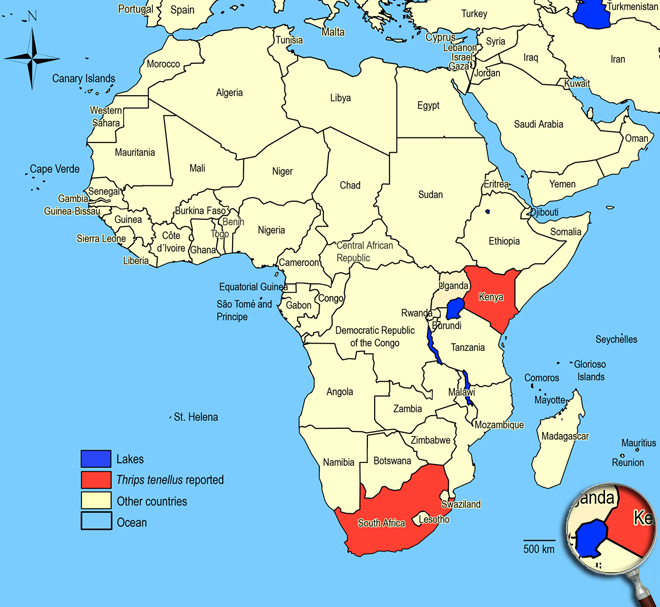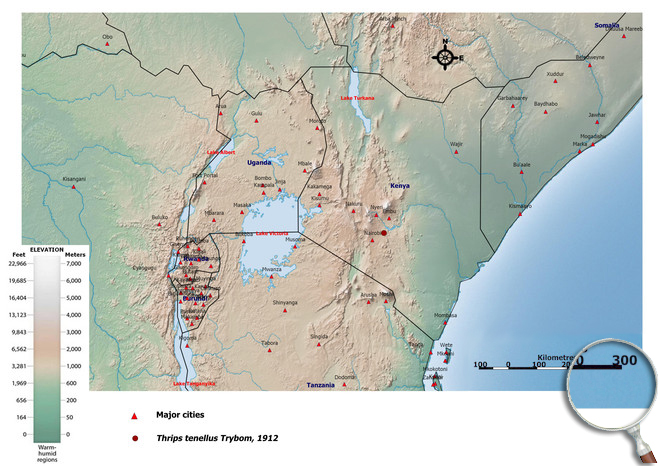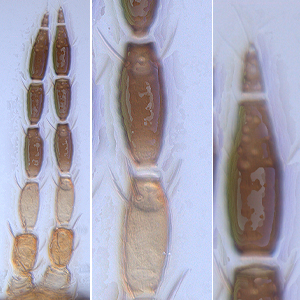Thrips tenellus Trybom, 1913
Thripinae, Thripidae, Terebrantia, Thysanoptera
Figures
Fig. 1: 7-segmented antenna, segments III and IV with forked sense cone, terminal segments VI and VII
Fig. 2: Head dorsal with ocellar triangle
Fig. 3: Pronotum
Fig. 4: Meso- and metanotum
Fig. 5: Fore wing and fore wing basal region
Fig. 6: Tergites III-VI
Fig. 7: Tergites VII-IX
Fig. 8: Tergites IX and X
Introduction and recognition
Thrips tenellus is a flower-dwelling thrips particularly of mango. Both sexes fully winged. Body and legs yellow; tergites II-VII with brown median area and dark antecostal ridges; tergite X brown at apex; antennal segments I-III yellow, IV-VII brown; fore wings uniformly pale. Antennae 7-segmented; segments III & IV slightly constricted at apex and with short forked sense cone (Fig. 1). Head as wide as long; with 2 pairs of ocellar setae, pair I absent, pair III arising outside ocellar triangle and lateral to fore ocellus (Fig. 2). Pronotum with transverse lines of sculpture and about 40 discal setae; with 2 pairs of long posteroangular setae; posterior margin with 3-4 pairs of setae; anterior margin with 3-5 pairs of setae (Fig. 3). Mesofurca with spinula. Metanotum with transverse lines at anterior, almost longitudinally striate and converging on posterior half; median setae arising behind anterior margin; campaniform sensilla absent (Fig. 4). Mid and hind tarsi 2-segmented. Fore wing first vein with 3 setae on distal half; second vein with a complete row of about 15 setae; clavus with 5 marginal setae, clavus terminal seta longer than subterminal seta (Fig. 5). Tergite II with 4 lateral marginal setae; V-VIII with ctenidia present laterally (Fig. 6), on VIII posteromedial to spiracles; posterior margin of VIII with complete comb of microtrichia that are small and irregular in length (Fig. 7 and 8); pleurotergites with 3-5 discal setae. Sternite II with 2 pairs of marginal setae, III-VII with 3 pairs, median marginal setae on VII arising in front of posterior margin; sternite II with about 5 discal setae, III-VII with 30 or more discal setae arranged in more than one irregular row.
Male similar to female in structure, but smaller.
Taxonomic identity
Species
Thrips tenellus Trybom, 1913
Taxonomic history
Thrips alni tenella Trybom, 1913
Common name
-
Present taxonomic position
Family: Thripidae Stephens, 1829
Subfamily: Thripinae Stephens, 1829
Genus: Thrips Linneaeus, 1758
Genus description
The genus Thrips L., 1758
There are nearly 300 species currently recognized in the genus Thrips making this genus one of the largest taxa within the order Thysanoptera. The genus was redefined progressively during the 1970's (see Mound et al. 1976), to include many species previously placed in Taeniothrips. The genus Thrips now includes a range of species, some with the antennae 7-segmented, others 8-segmented, and a few with the number of segments varying between 7 and 8. Similarly, some species have few setae on the fore wing first vein, whereas others have a complete row of setae on this vein. The species with a complete setal row on the first vein were placed from some taxonomists in the genera Isothrips or Isoneurothrips. However, all of the species in Thrips have the following character states: antennal segments III & IV with forked sense cone, absence of ocellar setae I, pronotum with 2 pairs of elongate posteroangular setae, paired ctenidia laterally on the tergites V-VIII, tergite VIII ctenidium arising posterior to the spiracle (in contrast to species of the genus Frankliniella). Other character states, such as number of antennal segments, number of setae on the fore wing veins, and number of discal setae on the abdominal sternites are variable between species (Mound & Masumoto 2005; Nakahara 1994; Palmer 1992). Identification keys are available for the species of this genus from many parts of the world. Of particular importance is the published key by Mound (2010) for members of the genus Thrips from Afro-tropical region as well as previous Lucid keys from Moritz et al. (2001, 2004, 2009).
Species description
Typical key character states of Thrips tenellus
Coloration and body sculpture
Body color: mainly pale to yellow, or with some darker markings
Surface of head, pronotum and fore legs: without obvious or with weakly reticulate sculpture
Antennae
Number of antennal segments: 7
Antennal segment I: without any setae on dorsal apical margin
Antennal segment II: without an exceptionally long seta at the inner apex
Antennal segment II shape: symmetric
Antennal segment III shape: symmetric
Length of antennal segment III and IV: antennal segment III similar in length to segment IV
Form of sense cones on antennal segments III and IV: emergent and forked on segments III and IV
Forked sense cone on antennal segment IV: scarcely extending beyond base of segment V
Antennal segment IV and V: without a hyaline ring near the base
Antennal segment VI bears: not a remarkably dagger-shaped sensorium
Head
Distance between bases of ocellar setae III: greater than width of first ocellus
Head: not prolonged in front of compound eyes
Ocellar setae I: absent
Length of ocellar setae II: shorter than setae III
Ocellar setae III: arising on anterior margin of, or in front of ocellar triangle
Ocelli: present
Length of postocular setae: not alternating short and long setae
Number of ocellar setae: 2
Prothorax
Number of pairs of anteromarginal minor setae: 3-5
Number of pairs of long anteroangular setae: 0
Number of pairs of long posteroangular setae: 2
Number of pairs of elongate pronotal setae: 2
Number of pairs of posteromarginal minor setae: 3-4
Pronotal blotch or internal apodeme: absent
Pronotum shape: broadly rectangular
Pronotum posteromarginal/posteroangular setae: S2 longer than S3, not equal in length
Mesothorax
Mesosternal furca: with median spinula
Metathorax
Metanotal campaniform sensilla: absent
Metanotal median setae: S1 behind anterior margin
Metanotum with dominant sculptured triangle medially: absent
Metasternal furca: without spinula
Sculpture of metanotum median area: transverse at anterior, but longitudinal and parallel on posterior half
Shape of metathoracic furca: transverse, V-shaped
Wings
Fore and hind wings: present, more than half as long as abdomen (macropterous)
Fringe cilia arising: from sockets
Fore wing veins: present
Fore- and hind wing surface: covered with microtrichia
Apex of fore wing: with prominent terminal setae
Fore wing anterior margin (costal vein): with setae and cilia but cilia longer than setae
Fore wing clavus - number of marginal setae: 5
Fore wing clavus - terminal veinal seta: longer than subterminal seta
Fore wing costal fringe cilia: arising at anterior margin of wing
Fore wing first vein: distinct from costal vein
Fore wing first vein setal row: incomplete, with setae not closely and uniformly spaced
Fore wing second vein setal row: complete, setae uniformly spaced
Fore wing shape: mainly parallel sided or margins run continuously towards each other
Fore wing surface: not reticulate
Fore wing first vein number of setae on distal half: 3
Fringe cilia on posterior margin near apex: distinctly wavy (undulated)
Shape of fore wing apex: with mainly posterior margin curved to join anterior margin
Fore wing extreme apex color: pale
Fore wings: uniformly pale or weakly shaded
Legs
Fore tibia: not prolonged around fore tarsus
Mid and hind tarsi: with two segments
Color of fore tarsi: pale or yellow, sometimes apical shaded or brown
Abdomen
Pleurotergal discal setae: present
Pleurotergites: not covered in microtrichia
Number of pleurotergal discal setae: 3-5
Sternite II: with marginal setae and few discal setae
Number of discal setae on sternites III to VI: (24) 28-30 (35)
Sternites IV, V and VI: with marginal setae and discal setae medially
Pairs of posteromarginal setae on sternites V and VI: 3
Sternite VII median posteromarginal setae S1: arising in front of posterior margin
Sternite VII: with marginal setae and discal setae present on median area
Surface of lateral thirds of abdominal tergites: without regular rows of fine microtrichia
Number of lateral marginal setae on tergite II: 4
Sculpture of tergites II to VIII: with one or without transverse lines of sculpture between median pair of setae S1
Color of tergites II to VII: yellow with brown median area
Tergites II to VII median setal pair: no more than 0.3 as long as median length of tergite
Tergites IV and V median setal pair: shorter than distance between their bases
Markings on tergites IV to VI: with shaded areas medially
Craspedum on tergites IV to VI: absent
Tergites V to VII: with ctenidia laterally
Craspedum on tergite VIII: without craspedum medially and toothlike microtrichia laterally
Tergite VIII ctenidia: posteromedial to spiracle
Tergite VIII posteromarginal comb of microtrichia: present and complete medially
Tergite VIII shape of posteromarginal microtrichia: short and irregular in length
Tergite X: not tubular, longitudinally incomplete
Setae on abdominal tergite X: all setae slender

Similar or related species
Thrips tenellus is very similar to some other Thrips species - like Thrips australis, Thrips microchaetus and Thrips subnudula. Thrips tenellus has sternites III-VII with at least 1 pair of discal setae and pleurotergites with discal setae (Thrips acaciae, Thrips brevisetosus, Thrips florum, Thrips gowdeyi, Thrips hawaiiensis and Thrips simplex, all of them have sternites III-VII with at least 1 pair of discal setae and pleurotergites without discal setae; Thrips orientalis and Thrips parvispinus, both have discal setae on sternites III-VI but not on sternite VII, and no discal setae on pleurotergites; Thrips nigropilosus, Thrips palmi, Thrips pusillus and Thrips tabaci, all of them have sternites and pleurotergites without discal setae).
Inside this group Thrips tenellus is the only species without campaniform sensilla on metanotum (in other three species present). Most of the species possess a fore wing first vein with a wide gap before distal group of setae (only Thrips australis with an almost complete setal row on fore wing first vein), pleurotergites without many rows of fine microtrichia (only in Thrips subnudula present), and sternites III-VI with 3 pairs of posteromarginal setae (except for Thrips subnudula with 5-7 pairs of posteromarginal setae). Thrips tenellus as well as Thrips microchaetus have ocellar setae III arising outside ocellar triangle and lateral to fore ocellus (in Thrips australis ocellar setae III arising on or just within anterior margins of ocellar trinagle; in Thrips subnudula ocellar setae III arising close together behind first ocellus within the triangle), the metanotal median area sculptured lines are transverse at anterior, but longitudinal and parallel on posterior half (in Thrips australis median area with mainly equiangular reticulation; Thrips subnudula with sculptured lines transverse at anterior, but forming equiangular or irregular longitudinal reticulations on posterior half), and both have a complete posteromarginal comb of microtrichia on tergite VIII (compared to Thrips australis and Thrips subnudula with tergite VIII posteromarginal comb absent medially). In structure Thrips tenellus is particularly similar to Thrips microchaetus, but has a brown median area and dark antecostal ridges on tergites II-VII, no campaniform sensilla on metanotum, and pleurotergites with only 3-5 discal setae. Whereas Thrips microchaetus lacks the dark median tergal markings and the dark tergal antecostal ridges, the species has campaniform sensilla on metanotum, and pleurotergites with 6 or more discal setae.
Species of the genus Thrips are similar to species of Stenchaetothrips, Microcephalothrips abdominalis, Larothrips dentipes and Fulmekiola serrata because of tergites V-VIII bear a pair of ctenidia laterally, which placed on tergite VIII posteromedial to the spiracle, and all species have no ocellar setae I on head. In contrast to species with craspedum on tergites II-VII (Microcephalothrips abdominalis, Larothrips dentipes and Fulmekiola serrata), species of Thrips and Stenchaetothrips have no posteromarginal craspedum on tergites and sternites. Species of the genus Thrips as well as Fulmekiola serrata and species of Stenchaetothrips have 2 pairs of elongate posteroangular setae (Microcephalothrips abdominalis with 2 pairs of moderately elongate pronotal setae and Larothrips dentipes without elongate setae). Compared to the species of Thrips, Microcephalothrips abdominalis, and Larothrips dentipes, which have ocellar setae II much shorter than or about as long as III, Fulmekiola serrata and species of Stenchaetothrips have ocellar setae II much longer than III, and sternites always without discal setae.
Biology
Life history
As with other thrips species the life cycle from egg to adult is dependent on temperature. The full cycle can take about 15 days (Lewis 1973) to over a month. Adults may live for more than one month producing several generations in one year depending on seasons.
Host plants
Litchi, mango, Tagetes minuta.
Vector capacity
None identified, but possible mechanical distribution of phytopathogenic fungi and bacteria.
Damage and symptoms
Thrips tenellus is the most abundant thrips infesting mango flowers. Its numbers are high at flowering and later declines. However there is no evidence on how they influence the fruit set and they are not observed during fruiting (Grové et al. 2001).
Detection and control strategies
-
Additional notes
-
Biogeography
East and South Africa. Kenya (Thika), South Africa (KwaZulu-Natal: Stanford Hill; Mpumalanga: Nelspruit).
African countries where Thrips tenellus has been reported

Occurence of Thrips tenellus in East Africa

Please click here for survey sites of all observed thrips species of Kenya, Tanzania and Uganda.
Click here for locations of Thrips tenellus in parts of East Africa.

Bibliography
Grové T, Giliomee JH & Pringle KL (2000). Seasonal abundance of different stages of the citrus thrips, Scirtothrips aurantii, on two mango cultivars in South Africa. Phytoparasitica. 28 (1): 43-53
Grové T, Giliomee JH & Pringle KL (2001). Thrips (Thysanoptera) species associated with mango trees in South Africa. African Entomology. 9 (2): 153-162
Lewis T (1973). Thrips: their biology, ecology and economic importance. Academic Press Inc., London Ltd., 349 pp
Moritz G, Morris DC & Mound LA (2001). ThripsID - Pest thrips of the world. ACIAR and CSIRO Publishing Collingwood, Victoria, Australia, CDROM ISBN 1 86320 296 X
Moritz G, Mound LA, Morris DC & Goldarazena A (2004). Pest thrips of the world - an identification and information system using molecular and microscopical methods. Centre for Biological Information Technology, University of Queensland, Australia, CDROM ISBN 1 86499 781 8
Moritz G, O'Donnell C & Parrella M (2009). Pest thrips of North America. Centre for Biological Information Technology, University of Queensland, Australia, CDROM ISBN-13: 978 1 86499 940 2
Mound LA (2010). Species of the genus Thrips (Thysanoptera, Thripidae) from the Afro-tropical Region. Zootaxa. 2423: 1-24
Mound LA & Masumoto M (2005). The genus Thrips (Thysanoptera, Thripidae) in Australia, New Caledonia and New Zealand. Zootaxa. 1020: 1-64
Mound LA, Morison GD, Pitkin BR & Palmer JM (1976). Thysanoptera. Handbooks for the identification of British insects, Vol. 1, Part 11. Royal Entomological Society of London, London, 79 pp
Nakahara S (1994). The genus Thrips Linnaeus (Thysanoptera: Thripidae) of the New World. Technical Bulletin, USDA, Agricultural Research Service. 1822: 1-183
Nickle DA (2006). A review of the species of Thrips Linnaeus, 1758 (Thysanoptera: Thripidae) from Africa, Europe, and the Mediterranean region. Proceedings of the Entomological Society of Washington. 108 (2): 443-466
Palmer JM (1992). Thrips (Thysanoptera) from Pakistan to the Pacific: a review. Bulletin of the British Museum (Natural History), Entomology. 61 (1): 1-76
Trybom F (1913). Physapoden aus Natal und dem Zululande. Arkiv för Zoologi. 7 (33): 1-52
zur Strassen R (1960). Catalogue of the known species of South African Thysanoptera. Journal of the Entomological Society of Southern Africa. 23 (2): 321-367
zur Strassen R (1973). Thysanopterologische Notizen (2) (Ins.: Thysanoptera). Senckenbergiana Biologica. 54 (1-3): 141-156
zur Strassen R (2006). Checklist of the Thysanoptera (Insecta) of southern Africa. African Entomology. 14 (1): 63-68
----
Web links
Mound´s Thysanoptera pages
Thysanoptera Checklist
ICIPE Thrips survey sites
UNI Halle & Thrips sites
Thrips of California












